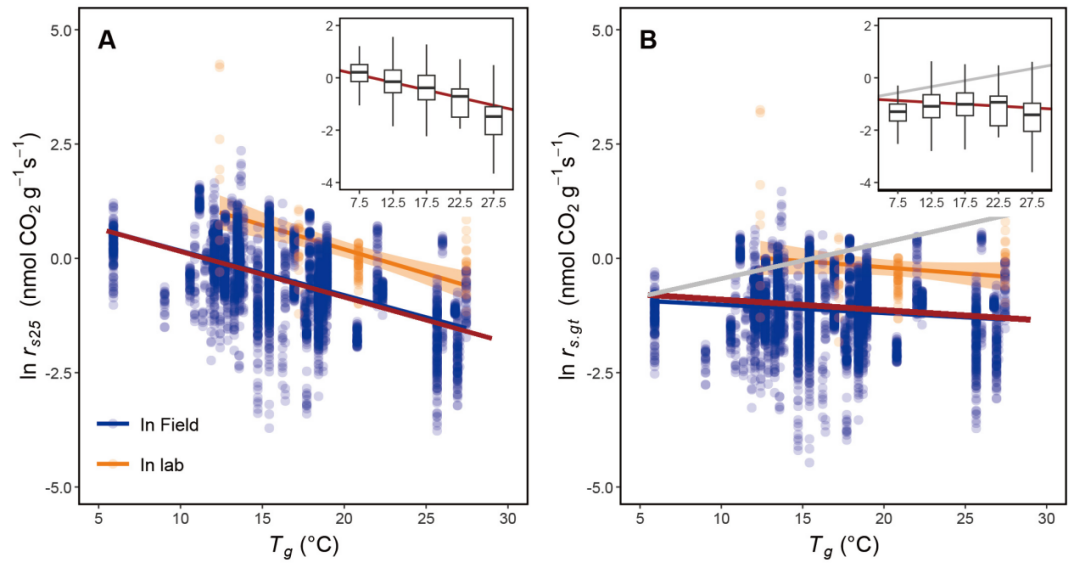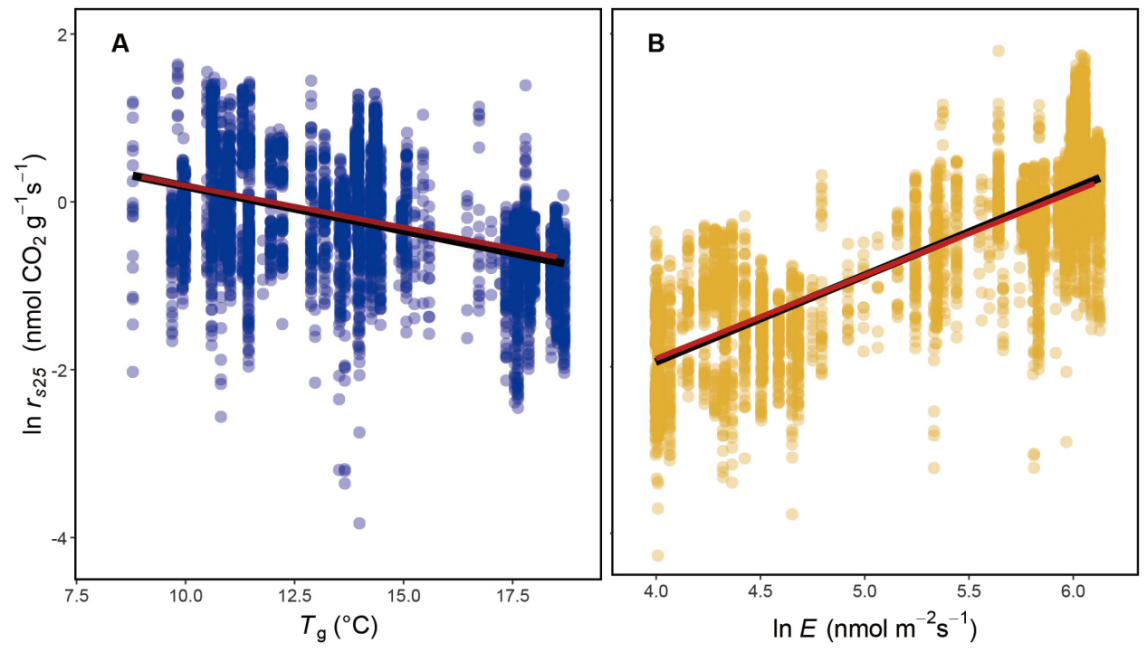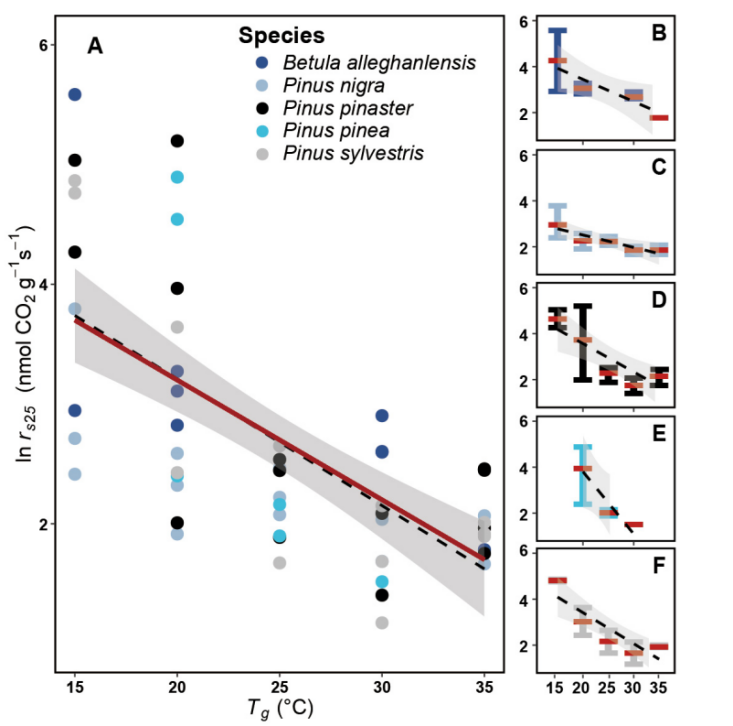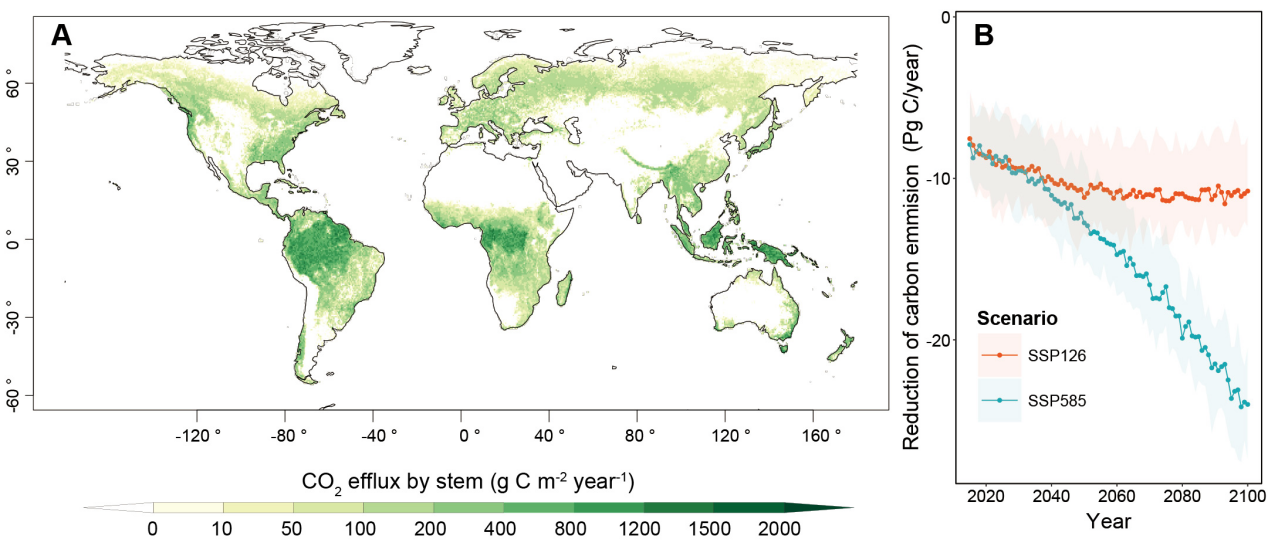Stem respiration, which releases carbon dioxide, is one of the important carbon emission sources in terrestrial ecosystems. Traditional views hold that rising temperatures will sharply enhance respiration, thereby exacerbating climate warming. However, recent studies have shown that plants can adjust to the warming environment through thermal acclimation. While thermal acclimation of respiration in leaves and root tissues has received much attention, whether stem respiration also exhibits thermal acclimation, its driving mechanisms, and how such acclimation will affect the global carbon cycle under long-term warming have remained insufficiently studied.
Associate Professor Wang Han's team from the Department of Earth System Science at Tsinghua University, in collaboration with groups from Australia, the UK, the US, and other countries, constructed a global database on woody plant stem respiration, demonstrating the universal existence of thermal acclimation in stem respiration. Based on the principle of ecological evolutionary optimality (EEO), the study for the first time independently predicted the thermal sensitivity of stem respiration to warming and proposed a new theory that transpiration rate and water viscous resistance regulate the spatiotemporal variation of global stem respiration. The research found that by 2100, thermal acclimation of stem respiration is expected to reduce carbon emissions from terrestrial ecosystems by 24% to 46%, which is crucial for mitigating climate-carbon feedback. The relevant results were published online as a long article in the journal Science under the title Thermal acclimation of stem respiration implies a weaker carbon-climate feedback.
Innovatively combining plant hydraulic transport with the principle of ecological evolutionary optimality, the study assumes that stem respiration is used to maintain the hydraulic continuum required for canopy transpiration, and its rate should be proportional to the transpiration rate and affected by water viscosity, thus maximizing carbon use efficiency. Considering the synergistic effects of temperature on xylem water viscosity, respiratory enzyme activity, and other multiple factors, the theory draws two key predictions: (1) For every 1℃ increase in temperature, the basal respiration rate per unit mass (measured at the reference temperature of 25℃, rs25) decreases by approximately 10.1%, and the respiration rate at growing temperature (rs.gt) decreases by approximately 2.3%; (2) The impact of canopy transpiration on the respiration rate per unit mass is mainly reflected in seasonal dynamics rather than spatial patterns.
To verify these predictions, the research team compiled the Global Stem Respiration Database (GSRD), incorporating 8,782 observation data from 68 field sites and 187 species, as well as a set of warming experiment data. The observation results showed that across the global spatial temperature gradient, the thermal sensitivity of the basal respiration rate (rs25) was –9.8±0.3 %K–1, and that of the respiration rate at growing temperature (rs.gt) was –1.5±0.3 %K–1, both very close to the theoretical predictions (Figure 1).

Figure 1. Global trends of stem respiration rate per unit mass at the reference temperature (rs25) and growing temperature (rs.gt) in relation to the growth temperature (Tg, mean temperature of the growing season with daily average temperature above 5℃). Note: Respiration data are presented as natural logarithms.
The study also confirmed thermal acclimation of stem respiration at the individual scale through seasonal observation data and warming experiments, verifying the reliability of the theory. Partial residual analysis based on seasonal observation data showed that the thermal sensitivity of the basal respiration rate (rs25) was –10.6±0.5% K–1, and the sensitivity to transpiration rate was 103.8±1.8% (Figure 2), both consistent with theoretical predictions. Furthermore, in a warming experiment conducted on saplings of five species, the rs25 decreased by approximately 10.6±1.6% K–1 after one week of warming treatment (Figure 3), also in line with theoretical predictions.

Figure 2. Partial residual plots of stem respiration to temperature and transpiration rate based on seasonal data. Note: Both respiration and transpiration data are presented as natural logarithms.

Figure 3. Changes in stem respiration with growing temperature in the warming experiment. Note: Respiration data are presented as natural logarithms.
This study further quantified the impact of thermal acclimation of stem respiration on global terrestrial ecosystem carbon fluxes. The results showed that the current annual total carbon emissions from global stem respiration are approximately 27.4±5.9 PgC, equivalent to 2 to 3 times the annual emissions from human activities (Figure 4A). Under the future climate scenarios of SSP126 and SSP585, if considering the thermal acclimation, the predicted values of stem respiration in 2100 could be reduced by 24% and 46%, respectively (Figure 4B). Existing Earth system models that do not account for stem thermal acclimation or use the thermal sensitivity of leaf respiration may overestimate the prediction of future climate-carbon positive feedback. This study provides important theoretical foundations and data support for revising the characterization of stem respiration in Earth system models.

Figure 4. Simulations and predictions of global stem respiration under current conditions and future scenarios.
Han ZHANG, a PhD student from the Department of Earth System Science at Tsinghua University, is the first author of the paper, and Associate Professor Han WANG is the corresponding author. Collaborators from Western Sydney University, the University of Reading, Imperial College London, the University of Exeter, and the University of California, Berkeley, participated in this study. The research was supported by projects such as the National Science Foundation of China, Hainan Institute of National Park Research Program, Tsinghua University Initiative Scientific Research Program, and Schmidt Sciences among others.
Editor: Li Han

